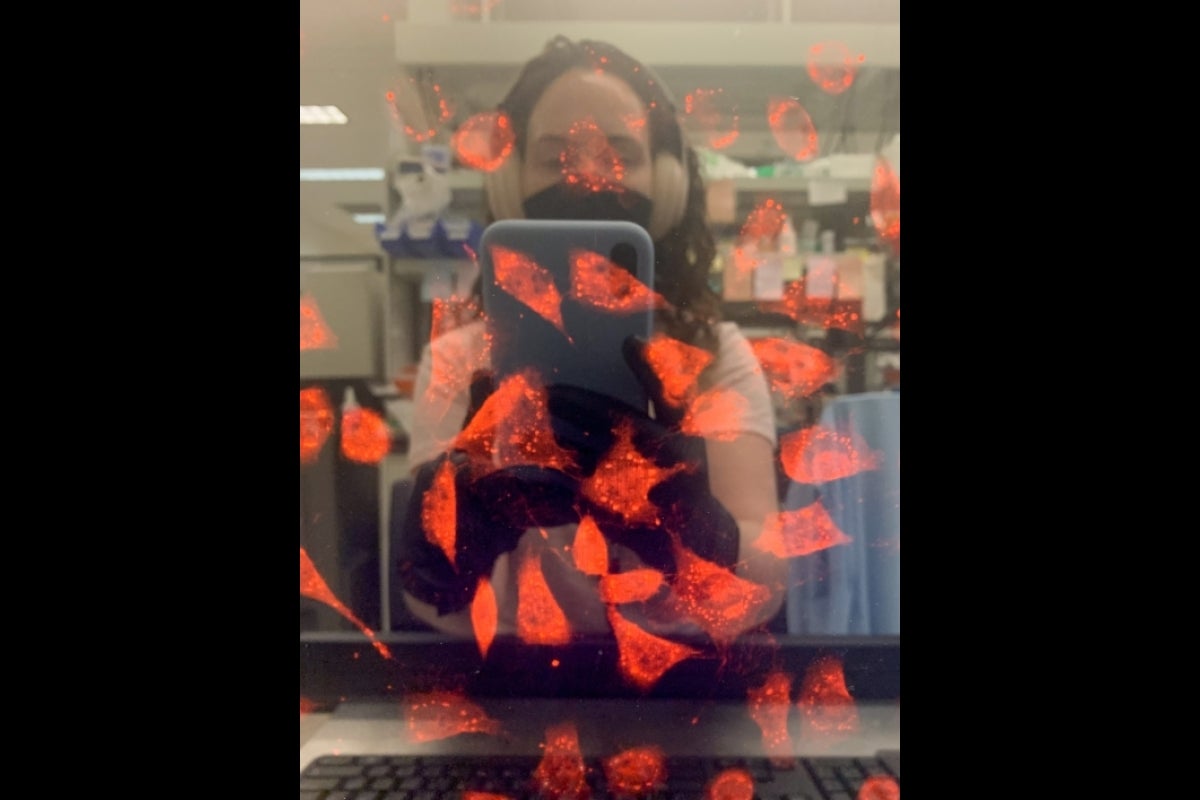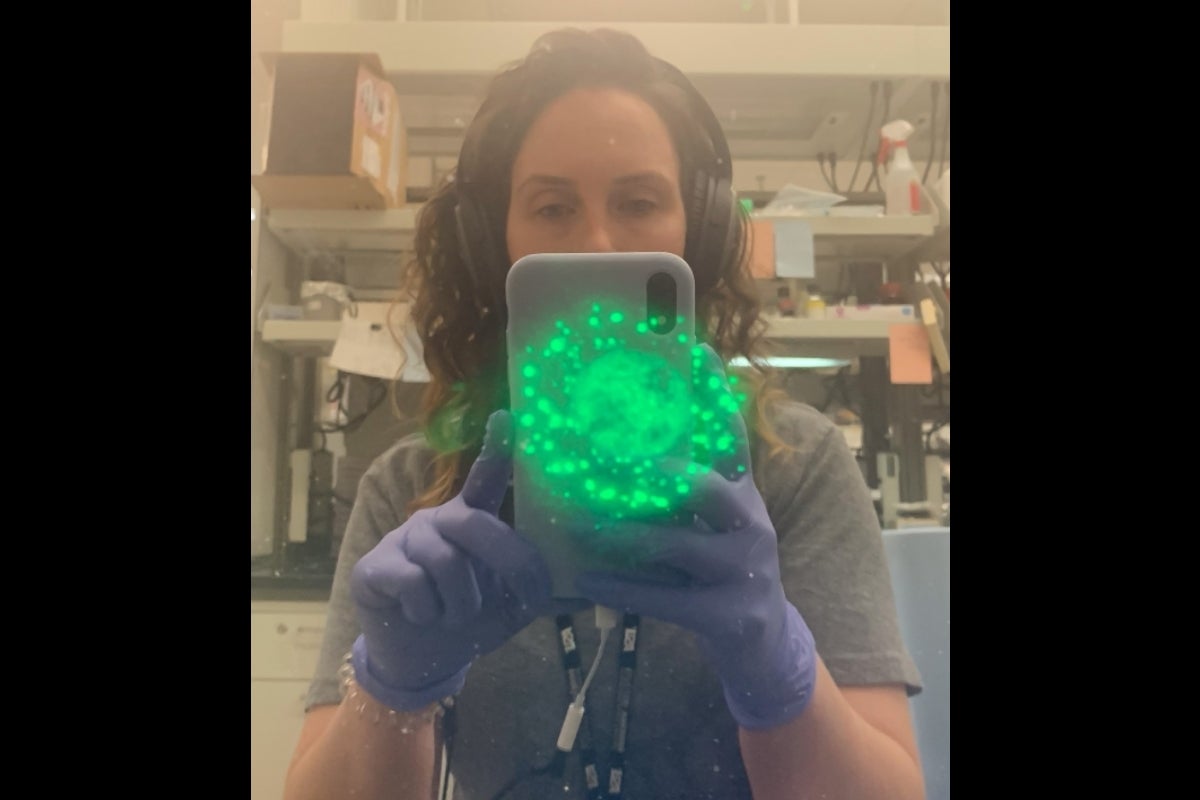Research illuminates 'programmed cell death' process induced by a common toxin

Cells that show how ZBP1 localizes to stress granules during arsenite-induced necroptosis. Photo courtesy Bertram Jacobs
Cells are the building blocks of our body and many other organisms. But did you know that sometimes cells need to die?
This might sound surprising but is actually a very important process, called "cell suicide" or "programmed cell death," for an organism to work properly.
Arizona State University Professor Bertram Jacobs, his former postdoctoral researcher Mateusz Szczerba, PhD candidate Megan McCaughan and other colleagues recently published a new article in the journal Science Signaling that provides new insight into the mechanism that leads to programmed cell death after exposure to arsenite, a common toxic chemical. Interestingly, this mechanism is similar to the one induced by a virus infection.
Jacobs is a well-known virologist who has produced world-leading research on the vaccinia virus, a cousin of the smallpox virus.
Cells are always on the lookout for intruders like viruses. They have certain weapons in their arsenal to help fight off these attacks; one is Z-DNA binding protein 1, or ZBP1. Under stress, like from a virus infection, ZBP1 targets stress granules. Stress granules are temporary storage aggregates for proteins and other molecules that help cells cope with stress. Once the stress is gone, the stress granules usually dissolve.
This interaction between ZBP1 and stress granules sends a signal to the cell, forcing it to commit a type of cell suicide called necroptosis. If the cell dies, it will prevent the virus from spreading to the other cells.
“To explore this hypothesis, we conducted experiments to determine if exposing cells to arsenite, a known inducer of stress granules, resulted in cell death,” said McCaughan, co-author of the article.
The process of cell suicide is like a self-destruct button that helps get rid of these infected or damaged cells. However, the cell’s decision to destroy itself is highly regulated and should not be taken lightly. During necroptosis, the cell swells up and eventually bursts, releasing all the cell contents, which can sometimes cause inflammation or harm nearby cells.
Cell suicide by necroptosis is good when the cell is fighting a virus and is worth the price of inducing some inflammation. However, as the new publication reveals, necroptosis also occurs when the cells become stressed after exposure to toxic chemicals like sodium arsenite.
McCaughan visualized the various key players involved in the cell death process using immunofluorescent techniques.
“This paper has been in the works for quite some time, and I was the first in our lab to successfully demonstrate the formation of stress granules using immunofluorescence, which has opened up many other opportunities,” she said.
“As an amateur photographer and avid space enthusiast, it was incredibly satisfying to explore and work with what I like to refer to as mini universes. Using immunofluorescent microscopy techniques and selectively staining for the stress granule protein G3BP1, the resulting imagery resembled the enigmatic beauty of galaxies or the death of a star (supernova). One of my favorite phrases or perspectives is that we are all star stuff, so I always felt like I was witnessing this phenomenon of death as it occurs within, just on a microscopic scale," McCaughan said.
The article details how sodium arsenite, a common toxin found in drinking water worldwide, induces oxidative stress in the cell and recruits ZBP1 protein to trigger cell suicide.
“The same pathway that we see that protects from virus infection we also see in oxidatively stressed cells (i.e., cells treated with sodium arsenite),” Jacobs said. “This is one of the first times that we have seen the same response to a chemical treatment.
“We think that arsenite induces this type of highly inflammatory cell death and leads to all the problems we know about over inflammation."
This research has important implications as it has shown how oxidative stress can generate a significant inflammatory response from necroptosis. Oxidative stress is caused by arsenite exposure and aging, potentially leading to aging-related diseases like Alzheimer’s.
“Clearly, this type of cell suicide protects us from virus infections, but does it leave us vulnerable, especially for diseases of aging?” Jacobs said.
Jacobs and his lab will continue this work and dive deeper into how arsenite treatment leads to this form of cell death, focusing on the role of reactive oxygen and oxidative stress.
“Having our manuscript accepted in Science Signaling was a tremendous achievement! ... Contributing to the scientific community’s understanding of the broad-reaching topic of cell death is a genuine honor. We hope our findings will inspire other researchers to explore and apply these discoveries to their respective domains,” McCaughan said.
Jacobs is a researcher in the Biodesign Center for Immunotherapy, Vaccines and Virotherapy and a professor in the School of Life Sciences and in the Center for Evolution and Medicine at ASU.
More Science and technology

Breakthrough copper alloy achieves unprecedented high-temperature performance
A team of researchers from Arizona State University, the U.S. Army Research Laboratory, Lehigh University and Louisiana State…

4 ASU researchers named senior members of the National Academy of Inventors
The National Academy of Inventors recently named four Arizona State University researchers as senior members to the prestigious…

Transforming Arizona’s highways for a smoother drive
Imagine you’re driving down a smooth stretch of road. Your tires have firm traction. There are no potholes you need to swerve to…




